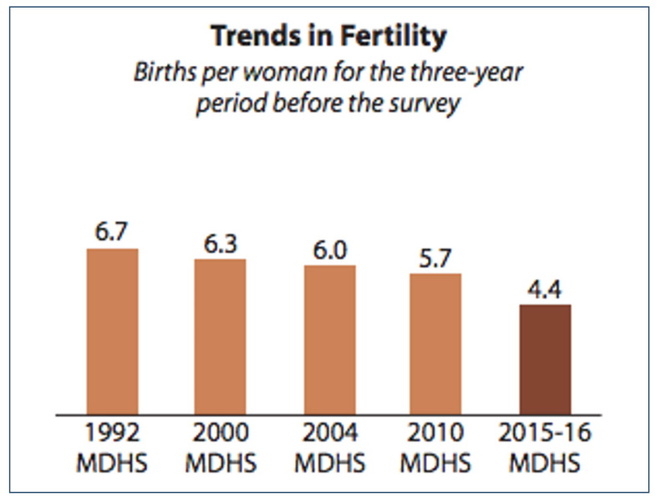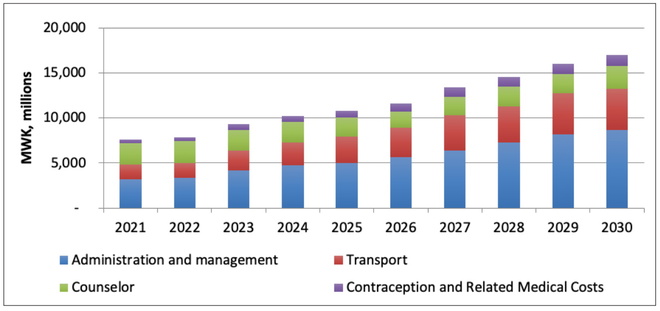Malawi Priorities: Family Planning
Technical Report
Key Messages
- Malawi’s modern contraception prevalence rate among married women increased substantially from 7% in 1992 to 58% in 2016, contributing to an overall reduction in total fertility rates over the last few decades.
- Globally, Malawi’s use of contraceptives is at par with countries such as Thailand whose GDP per capita is nearly twenty times larger. It has had the third-fastest reduction in total fertility rate since 2010 globally. Much of this success is attributable to the numerous government and donor programs that have proliferated in the recent past.
- Despite these successes, projections show Malawi’s population doubling again from 2020 to about 2050. The high population growth rate will make it harder for Malawi to meet the basic needs of its population. Further family planning interventions are necessary for reducing population growth and translating the associated demographic benefit into long-term economic growth, as noted in Malawi’s Vision 2063.
- The saturation of programming in this area makes identifying opportunities for further improvements challenging. This brief examines the costs and benefits of scaling a pilot program of post-partum counseling and subsidized contraceptives, including travel, nationwide. A key feature of this program is increased administration and management attention that improves the availability of contraception and transportation services for beneficiaries.
- If scaled nationwide for 10 years, this intervention would reach 2.3 million married women, avoiding: 4,700 low weight births; 156,000 unwanted or mistimed births; 6,800 deaths in children under the age of 5; and, 620 maternal deaths. If the intervention generates a 20% reduction in unwanted births, it would generate economic benefits (demographic benefit) equivalent to an increase of 0.7-1.9% per capita for all Malawians.
- The cost of this intervention is substantial, starting at MWK 7.8 billion in the first year rising to MWK 17 billion by year 10, with a total investment envelope equal to MWK 118 billion over 10 years. Despite the significant cost, the intervention is expected to generate benefits 37 times larger than its costs, bearing a BCR of 37 with almost all the benefit from the demographic benefit.
- While we recognize there may be more efficient approaches for implementing this program by using existing structures, such as community health workers and mobile clinics, we are unable to estimate the impact of these alternative interventions. Furthermore, evidence has shown scaled-up programs that cut costs are often unable to deliver the same results as pilot programs. Therefore, if policymakers would like to use alternative implementing approaches, they should first test to see if a small-scale rollout yields similar benefits.
Context
The population of Malawi is expected to double from 2020 to 2050. Reducing population growth is imperative for Malawi to unlock the benefits of a demographic benefit. Access to and use of contraception in Malawi has increased substantially over the past two decades. The modern contraception prevalence rate (mCPR) for married women has increased from 7% in 1992 to 58% in 2016. This increased access and use of contraception have coincided with a decrease in total fertility rates from 6.7 per woman in 1992 to 4.4 in 2016.
Malawi’s progress in promoting family planning is impressive when compared to similar countries. Contraceptive prevalence in Malawi in 2019 was greater than in any other country in East Africa, with the exception of Zimbabwe, despite Malawi having the second lowest GDP per capita in East Africa. Overall, Malawi has had the largest increase in the percent of women aged 15-49 using modern contraception and the third largest reduction in the total fertility rate from 2010 to 2019 in the world.
Figure 1: Total Fertility Rate Malawi (Source: Demographic and Health Survey, 2015-16)

The Government has been actively engaged in expanding access to family planning services in Malawi. Numerous policies have been developed including the Youth Friendly Health Services National Standards (2007); the Sexual and Reproductive Health and Rights Strategy for Young People (2009); Youth Friendly Health Services National Standards (2015); and, the National Youth Friendly Services Strategy (2015-2020). In 2016 the Malawi Government developed a Family Planning Implementation plan that highlighted the need for increased post-partum counseling and suggesting that it be prioritized particularly in 11 high priority districts.
Summary of Findings
The success and proliferation of programs have made it challenging to identify interventions with the potential to further reduce fertility and improve access to contraceptives. In this report, we focused on post-partum counseling plus free access to contraceptives, due to its prioritization in districts with the highest fertility rates, and evidence that it could reduce the number of pregnancies by 40% in the three years after birth. The intervention includes:
- Counseling in the period around birth
- Free contraceptives across various methods as desired by the beneficiary
- Free transport to clinics via the services of a dedicated driver
- Free treatment for side effects should any complications arise
This intervention would require hiring 900 counselors and one driver per 1,000 targeted women for two years.
Avoided Unwanted Births as a Benefit
If rolled out for 10 years, the intervention is expected to reach 2.3 million women who have just given birth. This would avoid nearly 120,000 unwanted births and 35,000 mistimed births. These avoided or better-spaced births generate a number of flow-on benefits:
- 6,800 avoided under 5 deaths due to improved birth spacing
- 4,700 fewer low weight births
- 620 avoided maternal deaths due to avoided births
- Demographic benefit associated with a reduction in population
Additionally, there are benefits of free transport and contraceptives for those who would still have used modern methods even without the intervention. The largest and most important of these benefits is the demographic benefit. The demographic benefit is an economic benefit that accrues to the entirety of Malawian society and includes a number of components including:
- A short-run increase in GDP per capita because the same resources are split across fewer people
- More attention and investment in remaining children lead to more schooling, better health, and higher future productivity
- More time for people, particularly women, to return to work which increases economic output
- Increased savings that can be invested into immediately productive assets
- A positive feedback loop where increased schooling, health, and wealth generates even more reductions in fertility leading to further economic gains
If the intervention reduces unwanted births in the target population by 20% per year, it would generate a demographic benefit increasing between 0.7% and 1.9% in GDP per capita per year in the long run.
Additional Government or Donor Investment Required
The additional government or donor investment required is MWK 118 billion over 10 years. This would be enough to provide for 2.3 million women. The largest costs are for transportation and administration, requiring around MWK 31.6 billion and 56.5 billion respectively over 10 years. Counseling as well as medical costs, including contraceptives require around MWK 22 billion and 8.3 billion respectively over 10 years. The costs of the project would be borne by governments or donor organizations.
Figure 2: Intervention Costs

Summary Table
| Intervention | BCR | Target Population | Avoided unwanted and mistimed births | Avoided low weight births | Avoided deaths in children under 5 years of age | Avoided maternal deaths | Demographic benefit | Cost per avoided death |
|---|---|---|---|---|---|---|---|---|
| Post-partum counseling and free access to contraceptives | 37 Excellent | All married women who have given birth in health facilities | 156,000 | 5,000 | 6,800 | 620 | Increases between 0.7% and 1.9% in GDP per capita per year | MWK 16 million |
Note: BCRs are based on costs and benefits discounted at 8% (see accompanying technical report). BCR ratings are determined on the following scale Excellent, BCR > 15; Good, BCR 5-15; Fair, BCR 1-5; Poor, BCR < 1. This traffic light scale was developed by an Eminent Panel including several Nobel Laureate economists for a previous Copenhagen Consensus project that assessed the Sustainable Development Goals.
Download the full policy brief here.

